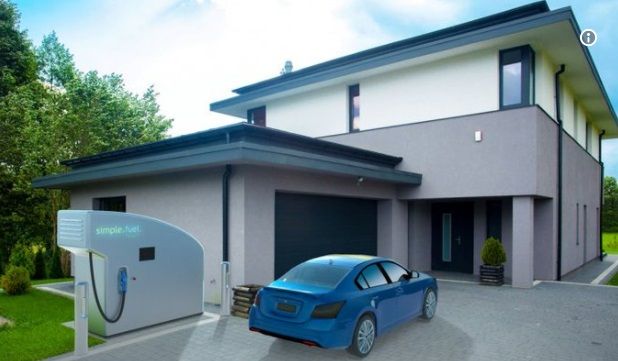... 200 kg of hydrgen stored at 700 bar would require tanks weighing around 4 metric tons, though.
Yeah, scuba tanks are heavy even when empty. And an AL80 scuba tank is typically filled to around 200 bar. 700 bar would require a much heavier tank.
You can install our site as a web app on your iOS device by utilizing the Add to Home Screen feature in Safari. Please see this thread for more details on this.
Note: This feature may not be available in some browsers.
... 200 kg of hydrgen stored at 700 bar would require tanks weighing around 4 metric tons, though.
How far would you reckon a semi could go with an electric motor and 500-600 kWh onboard?
How far would you reckon a semi could go with an electric motor and 500-600 kWh onboard?
Well, here's a completely unscientific estimate. Diesel Semis get 6-8 mpg. A Diesel Mercedes S-class gets about 30 mpg (highway). So say the semi takes about 5 times as much energy as an S class and then extrapolate from the Model S.
Your talking about a battery 5 times the size of the Model S and it takes 5 times as much energy, so say 300 miles (give or take 200 miles).
Actually I believe someone in this forum has a CHAdeMO at their home, so home quick charging does exist, although rare. If I remember correctly costs about $50k, definitely not as much as $250k.To be fair, nobody is going to be supercharging their Tesla at home. Nobody has that kind of wiring, and nobody needs to. A more measured response is that home filling of a hydrogen car is impractical and massively expensive, so that in the real world you will be going to an H2 filling station, where presumably filling happens much faster. (I used to heat my old farmhouse with LP gas, and it took a few minutes for the bulk truck to fill my 500-gallon tank. H2 is not propane, but a filling station can probably fill a hydrogen tank fairly quickly.) The real point is that at a quarter of a million dollars for the home station, nobody is going to be using those.
So the real comparison:
Tesla: Charge at home, use superchargers on the freeway, use extremely slow L2 charging off the major highways. Carbon footprint: moderate if you use grid power, zero if you use solar or wind power. 0 to 60 around 5 seconds for the slowest Tesla, under 3 seconds for the really quick ones. Electric motors: very reliable and long-lasting.
Clarity: No practical charging at home. Very few filling stations. Carbon footprint: H2 today is made from natural gas and releases a lot of carbon to make the H2. Theoretically H2 can be made from water and electricity, but nobody is doing that now. 0 to 60 9.2 seconds. Fuel cells: shorter lifespan than a modern ICE.
Actually I believe someone in this forum has a CHAdeMO at their home, so home quick charging does exist, although rare. If I remember correctly costs about $50k, definitely not as much as $250k.
From the article I read, the proposed hydrogen station is more suitable for fleet usage (like hydrogen forklifts) given the cost and low generation capacity (only 10kg per day, enough to fill 2-3 cars).
Okay. I stand corrected on that point. But why would anyone want or need a 62.5 kW charger at home?
Sure, if you installed it at home, the fueling speed would not matter because you either wouldn't fill the whole tank at once or you would have all night for it to fill. I think it's also telling that it's installed outdoors. Not only is there probably no room inside the garage for that huge thing, but leaks will escape outside and not be trapped by the garage ceiling leading to an explosion risk.The funny thing is that the linked page shows this guy installed at a home...

You do know that there is no "this guy".The funny thing is that the linked page shows this guy installed at a home...

You do know that there is no "this guy".
The picture is photoshopped.
Sounds delicious.this guy == simple fuel dispenser
And yes, I realize the picture is indeed photoshopped. This is not my first BBQ
And yes, I realize that TMC is not a BBQ joint, though I am slow cooking some ribs in the over for our annual HOA meeting in 30 minutes.
RT
Most houses in the USA do NOT have 3 phase power, and the CHAdeMO solutions that run off of single/split-phase home power tend to be much lower power... Like 12kW...
So, debatable if you could consider that "quick charging".
12KW Portable Fast DC Charger for Electric car-CHAdeMO charger,EV charger,leaf charger,Tesla charger,CCS chager-Electway Electric
DC Charging Page
Have seen some Mirais and one Clarity up close but didn't notice that loud noise. Will check out when I encounter those in the near future. Heard that FC stack requires extensive cooling.Pulled into the parking garage after lunch and passed a Clarity. Took a picture, and noticed a very loud sound from the front end. Upon leaving work several hours later, car was making the same sound. Took a video this time. Also looked like the running lights were on.
Outside temperature in the sun was easily 100+. Do FCEV's all make this kind of noise when sitting in a hot climate?
RT


